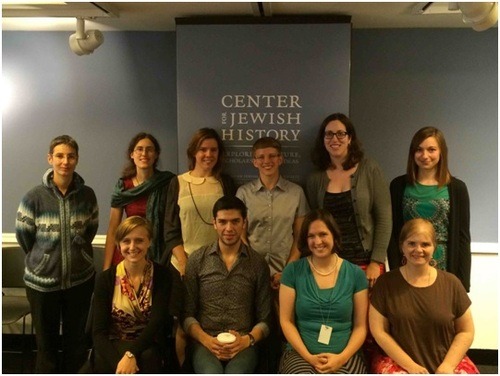by Ilana Rossoff, Reference Services Research Intern, Center for Jewish History
This post is part of the Jews and Social Justice Series. To view all posts in the series, click here.
Over the course of eight weeks of research and writing, I used some of the many resources offered by the Center for Jewish History for my independent project as a Research Intern. In the beginning, I sought to write a series on major Jewish-American leftist organizations, eager to dive deep into the AJHS archives of the Jewish Labor Bund and the Workmen’s Circle. Very quickly I came against a large obstacle in my research: language. Almost all of the Bund and Workmen’s Circle archives are in Yiddish, and I unfortunately do not read Yiddish. Thus I decided to look at organizations from the second half of the 20th century, presuming that many of the archives of the organizations I wanted to explore would be in English.
Initially I framed the project as a survey of Jewish New Left organizations, but I soon came to realize that the scope of the term “New Left” was temporally and demographically narrower than I had originally thought. For the purpose of joining together the various groups in which I was interested, I expanded the banner of the project to “Jewish social justice organizations.” The result was profiles of four organizations who considered themselves committed to social justice causes—the International Jewish Labor Bund, the Jewish Labor Committee, Jews for Urban Justice, and American Jewish Alternatives to Zionism—featured as posts on this blog. These organizations’ archival material is all housed in the AJHS collections at the Center for Jewish History. You can access it through the Lillian Goldman Reading Room.
My choice of these organizations stemmed from my interest in histories of groups of people who come together to collectively work for social change, be it social welfare or transformation of social/political structures. Throughout my research and writing, I sought to understand and highlight the underlying relationship between each organization and the Jewish community, asking, for whom did the social justice organization work—for their Jewish community, for their general community, or for the world at large?
I found that the organizations that initially sought to overcome issues directly affecting the Jewish community—the International Jewish Labor Bund and the Jewish Labor Committee—eventually expanded their work to encompass other social minority groups that experienced similar violence, disenfranchisement, or exploitation. The organizations that addressed issues directly impacting non-Jewish communities—Jews for Urban Justice and American Jewish Alternatives to Zionism—did so by engaging Jewish communities/audiences to challenge their participation in what they considered to be oppression and engage them in efforts against it. As such, the evolution of their work highlighted the impossibility of separating Jewish concerns from those of broader society and broader social concerns from Jewish communities. These organizations’ efforts to challenge social injustice from a Jewish vantage point blurred and bent the boundaries between Jewish and non-Jewish communities and, through political action, contributed to connections between Jews and non-Jews.
As an intern, I got to taste the experience of doing sustained research at the Center for Jewish History. I became very familiar with the CJH Library Catalog system and the process by which you can access any of the thousands of materials held in the libraries and archives of the Center’s five partner institutions. As a hopeful historian, I learned a crucial lesson about archive-based historical research and writing. While archival documents can provide a lot of essential information about the content of organizations’ programming, newsletters and press coverage, they are not sufficient for understanding the lived experience of these documents. For this, one needs a better understanding of the human dynamics that surrounded the documents, the circumstances out of which they were created and the ways in which people put these documents to use.
As my research was limited by geography and time constraints, I relied upon historical literature (accessed through the Lillian Goldman Reading Room at the Center) to provide me with broader contexts for the archival material I examined. This internship provided me the opportunity to flex the historical research and writing muscles I gained from college and add to them numerous new skills for conducting research in a major historical institution, which will invaluably benefit my future work.
My experience interning here was very unique. I found that the staff members of the Center are highly committed to ensuring that interns have meaningful learning experiences. Here, the intern’s learning experience is just as important as his/her contribution to the operations of the institution. I am grateful for having received the opportunity to research and write on subjects of my personal interest with the guidance and immense resources that the Center for Jewish History offers.

